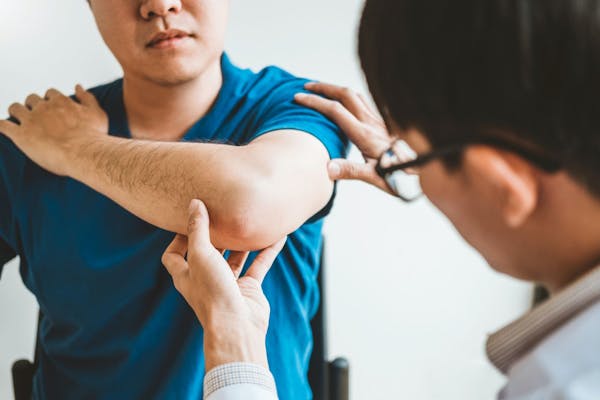Elbow

Elbow Fractures
Elbow fractures usually involve a fall onto the outstretched arm or a direct trauma to the elbow. With elbow dislocations there may be associated nerve and/or blood vessel injuries. X-rays may show the fracture or dislocation but small breaks may be difficult to see.
Fractures are an emergency and immediate reduction (or placing the bones together to allow healing) is necessary. Bone breaks within the joint need special attention to ensure recovery of proper function of the joints.
Ulnar Nerve Injuries
This injury is usually the result of excessive valgus stress on the elbow during repeated throwing (especially during the cocking phase of a throw). Sometimes a direct injury to the nerve within the cubital tunnel (“hitting your funny bone”) will result in nerve damage. Symptoms include tingling and numbness in the ring and pinky fingers. This may occur during or after throwing or with prolonged bending of the elbow.
Changing throwing technique, bracing if necessary, and therapeutic exercise may be helpful. If the problem persists, or there is prolonged weakness, then surgery is indicated.
Wrist

Fractures of the Forearm/Wrist
Fractures of the wrist and hands are commonly named for their anatomical location, how they occurred, or a doctor that discovered or studied the given type of fracture.
The fingers are susceptible to fracture in household mishaps, recreational injuries and work-related trauma.
Most hand fractures are stable and do not require surgery. However, occasionally, fractures will not heal without appropriate surgical intervention. Internal support or "hardware" is necessary to stabilize fractures. The therapist may apply a form fitting, custom thermoplastic splint to protect the fracture during healing. These splints may be removed for exercise and hygiene.
Most therapy programs commence days to 3 or 4 weeks post op, to regain motion, decrease pain, and reduce swelling. Rehabilitation may continue for weeks or months to restore range of motion (ROM) and strength.
Carpal Tunnel
Carpal tunnel syndrome is a compression of the median nerve within the carpal tunnel. There is pain, tingling, and in severe cases, numbness in the thumb, index middle and ½ of the ring finger. It is typically caused by repetitive tasks involving the hand and wrist. Typing with the wrists resting on hard surfaces can result in this problem.
It is often worse at night or with driving and can lead to loss of grip strength and coordination. As the problem progresses, atrophy (muscle wasting) of the thumb muscles may occur.
Treatment typically consists of splinting the wrist in a neutral position (no bend in the wrist in either direction), anti-inflammatory medication, and most importantly, activity modification such as wearing a padded glove during cycling. Surgical release of the transverse carpal ligament is often performed before muscle wasting occurs. Physical therapy follows to help restore range of motion, strength, and to educate the patient of factors that can lead to a reoccurrence of the problem.
